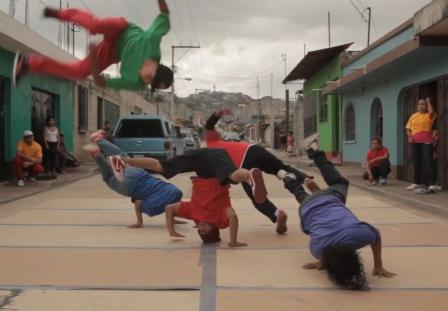Hip hop dance show for Peace Day in Guatemala

Interpeace and its local partners around the world celebrated Peace Day on 21 September with numerous events and activities involving thousands of people. In Central America, one of the highlights of the day was the performance in Guatemala City of the fascinating play, ‘La Danza de la Vida’ (meaning ‘The Dance of Life’), in front of more than 200 high school students, teachers, the country’s youngest ever Congressman, government officials and the media.
Overcoming violence through music and dance
Combining theater, music and dance with elements of hip hop, ‘La Danza de la Vida’ tells the story of Armando and Catherine, a boy and a girl from very different backgrounds as they overcome the violence and repression which fills their everyday lives. The dance expresses their dreams of a better world, filled with music, color, harmony and hope.
Catherine comes from a Mayan community whose family was displaced to Guatemala City following the internal armed conflict, during which a large part of her village was massacred. Armando grew up in a poor urban neighborhood and lost his brother and several friends in street fights involving both gangs and police, in extrajudicial killings. When they meet in Guatemala City, the two characters discover that in fact, despite their differences, there are several commonalities in their day to day life, where violence seems to be the main ingredient. This systematic violence that surrounds the lives of millions of youth marginalizes them and limits their opportunities for a better life.
Denouncing the marginalization of youth
The play brings together tradition with contemporary dance elements in a tribal and futuristic performance. Through the story of the Catherine and Armando, ‘La Danza de la Vida’ depicts the situation of many young people who, due to a difficult upbringing, lack a cultural identity of their own. Yet even when they use their imagination to try to create one, giving rise to youth movements known as ‘urban tribes’, they are repressed and criminalized by the state authorities and the justice system. But despite the adverse conditions, the youth strive to overcome this persistent hostility against them.
Violence is endemic and seems to be deeply-rooted within the societies of Central America. Young people are particularly at risk as victims as well as perpetrators of violence. Governments often apply a repressive approach or an approach that exclusively targets security issues and does not analyze the main social dimension of violence. Overall, young people are considered part of the problem but not part of the solution and their contributions are often considered irrelevant.
Youth as a solution rather than a problem
Interpeace’s Central American Youth Programme seeks to build a better understanding of issues affecting the youth of the region, in particular youth-related violence. Operating at the local, national and regional level in Belize, Costa Rica, El Salvador, Guatemala, Honduras, Nicaragua and Panama, Interpeace’s Youth Programme focuses on children and young people from all levels and sectors of societies. It engages them in creative activities designed to strengthen the capacity of the youth of the region, society at large and the state to come together and constructively address the issue of violence and the negative impacts of conflict.
